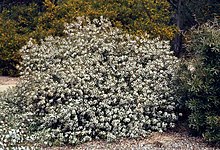Philotheca myoporoides subsp. myoporoides
Philotheca myoporoides subsp. myoporoides, commonly known as long-leaf wax flower,[2] is a subspecies of flowering plant in the family Rutaceae and is endemic to south-eastern continental Australia. It is a shrub with oblong to elliptic or egg-shaped leaves and white or pink flowers arranged in groups of three to eight in leaf axils.
| Long-leaf wax-flower | |
|---|---|
 | |
| In the Australian National Botanic Gardens | |
| Scientific classification | |
| Kingdom: | Plantae |
| Clade: | Tracheophytes |
| Clade: | Angiosperms |
| Clade: | Eudicots |
| Clade: | Rosids |
| Order: | Sapindales |
| Family: | Rutaceae |
| Genus: | Philotheca |
| Species: | |
| Subspecies: | P. m. subsp. myoporoides |
| Trinomial name | |
| Philotheca myoporoides subsp. myoporoides | |
| Synonyms[1] | |
|
List
| |

Description
Philotheca myoporoides subsp. myoporoides is a shrub, sometimes a small tree, that typically grows to a height of 2.5 m (8 ft 2 in) with glabrous, slightly to moderately glandular-warty stems. The leaves are variable in shape, oblong to elliptic or broadly elliptic to egg-shaped with the narrower end towards the base, 20–110 mm (0.79–4.33 in) long, 6–22 mm (0.24–0.87 in) wide and glandular-warty with a prominent midrib. The flowers are mostly arranged in groups of three to eight in leaf axils on a peduncle 0.5–20 mm (0.020–0.787 in) long, each flower on a pedicel 4–10 mm (0.16–0.39 in) long. The petals are broadly elliptic, white to pink and about 8 mm (0.31 in) long and the stamens are free from each other and hairy. Flowering occurs from July to January and the fruit is about 7 mm (0.28 in) long with a beak about 3 mm (0.12 in) long.[2][3][4]
Taxonomy and naming
In 1824, de Candolle described Eriostemon myoporoides in his book Prodromus Systematis Naturalis Regni Vegetabilis,[5][6] and in 1988 Michael Bayly changed the name to Philotheca myoporoides in the journal Muelleria.[7][8] In the same paper, Bayley described nine subspecies, including subspecies myoporoides.[9]
Distribution and habitat
Subspecies myoporoides is the most widespread and most variable of the species and occurs along the Great Dividing Range, mainly from Denman in New South Wales to near Healesville in Victoria. It grows in forest and heath, often near watercourses or on rocky hillsides.[3][4]
References
- "Philotheca myoporoides subsp. euroensis". Australian Plant Census. Retrieved 7 August 2020.
- Herscovitch, Clare. "Philotheca myoporoides (DC.) Bayly subsp. myoporoides". Royal Botanic Garden Sydney. Retrieved 7 August 2020.
- Wilson, Paul G.; Wilson, Annette J.G. (ed.) (2013). Flora of Australia (Volume 26). Canberra: Australian Biological Resources Study. pp. 391–392. Retrieved 7 August 2020.CS1 maint: extra text: authors list (link)
- Bayly, Michael J.; Stajsic, Val. "Philotheca myoporoides subsp. myoporoides". Royal Botanic Gardens Victoria. Retrieved 7 August 2020.
- "Eriostemon myoporoides". APNI. Retrieved 7 August 2020.
- de Candolle, Augustin Pyramus (1824). Prodromus Systematis Naturalis Regni Vegetabilis (Volume 1). Paris: Sumptibus Sociorum Treuttel et Würtz. p. 720. Retrieved 7 August 2020.
- Bayly, Michael J. (1998). "Notes on the Eriostemon myoporoides (Rutaceae) species complex, including new names and a new generic placement in Philotheca". Muelleria. 11: 113–126. Retrieved 7 August 2020.
- "Philotheca myoporoides". APNI. Retrieved 7 August 2020.
- "Philotheca myoporoides subsp. myoporoides". APNI. Retrieved 7 August 2020.